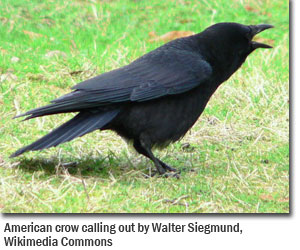American Crow
(Corvus brachyrhynchos)
Description and Range:
The American crow is the largest crow in North America. It has a glossy, all-black plumage with a relatively long, dark bill and dark legs. In flight, the crow has a rather long, fan-shaped tail. Juveniles are similar to adults, but they have a pale iris and a brownish overall tinge to their plumage. Crows, on average, are 17-21 inches in length. When crows molt, the old feathers can appear brownish or scaly compared to the glossy new feathers. American crows look nearly identical to fish crows and common ravens. Their calls, however, are much different than either species’ calls.
American crows can be found throughout much of the United States throughout the year as well as in Canada during the summer breeding season. American crows are common in every county in Maryland.
Habitat:
American crows are common birds of fields, open woodlands, and forests. They thrive around people; you can commonly see them in treetops, fields, roadsides, city garbage dumps, and in habitats ranging from open woods and empty beaches to town centers. Generally, they avoid deserts, though.
Diet:
American crows are opportunistic feeders and will eat a vast array of foods, including grains, seeds, nuts, fruits, berries, and many kinds of small animals such as earthworms and mice. They eat many insects, including some crop pests, and also eat aquatic animals such as fish, young turtles, crayfish, mussels, and clams. A frequent nest predator, the American crow eats the eggs and nestlings of many species including sparrows, robins, jays, terns, loons, and eiders. American crows will further eat carrion and garbage.
Reproduction:
American crows reach sexual maturity around 2 years of age, though most do not breed until they are at least 4 years old. After mating, both members of a breeding pair help build the nest. Young birds from the previous year sometimes help as well.
The nest is made principally of medium-sized twigs with an inner cup lined with pine needles, weeds, soft bark, and/or animal hair. Females will lay 3-9 eggs and incubate them for 16-18 days. Eggs are a pale bluish-green to olive green with blotches of brown and gray toward the large end. Upon hatching the chicks are naked except for sparse tufts of grayish down; their eyes are still closed and they are quite clumsy. A pair of crows can have up to 2 broods per year. Often the young stick around to help raise future siblings. Crow families can contain up to 15 individuals spread out over 1-5 generations.
 Sounds:
Sounds:
Interestingly enough, crows have more than 20 different calls. However, the most common sound they make is the harsh and throaty “caw-caw” noise. Sometimes crows make a “subsong” which is a mixture of hoarse or grating coos, caws, rattles, and clicks.
Behavior:
American crows are very social animals that sometimes form flocks numbering in the millions. Crows are extremely inquisitive and sometimes mischievous. They are adept at learning and can often solve problems as well as design and use tools. Sometimes their intelligence aids them in raiding garbage cans. American crows are also aggressive and often chase away larger birds including hawks, owls and herons.
In the winter, crows often congregate in large, communal nests that can contain hundreds to millions of other birds. Some communal roosts have been observed in the same place for over 100 years.
Management:
American Crow populations have been slightly but significantly increasing over last half of twentieth century. American crows, however, are extremely susceptible to West Nile Virus.
American crows are managed as small game in Maryland. To find out more about small game management, then please click here.
Did you know?
American crows sometimes follow adult birds to discover their nests for prey. American crows also will sometimes steal food from other animals. In one instance, a group of crows was seen distracting a river otter to steal its fish! They also sometimes follow songbirds as they arrive from a long migration flight and capture the exhausted birds. Crows also catch fish, eat from outdoor dog dishes, and take fruit from trees.